Snubnose revolvers are viable options when deciding what type of self-defense firearm to purchase. They are easy to use and easy to conceal. Plus, the 38 Special cartridge is an excellent self-defense round, and 38 Special +P loads are almost as powerful as a 357 Magnum rounds. We procured three snubnose revolvers under $400 — the Smith & Wesson Model 637-2, Smith & Wesson M&P Bodyguard 38, and the Taurus Model 856 — to see which one would come out as top dog.
In our opinion, all three of these snubnose revolvers are good choices for concealed carry and home defense. All have attributes that make them well suited for conceal carry, such as light weight, small grips, and smooth, snag-free outside edges. Sights are a big consideration, and we like them large and easy to use, and if we have the ability to modify the sight, that is a plus in our book. The triggers also need to be smooth because these revolvers will mostly likely be fired in double-action (DA) mode. Plus, we think the ability to fire 38 Special and 38 Special +P ammo through the revolver enhances its versatility.
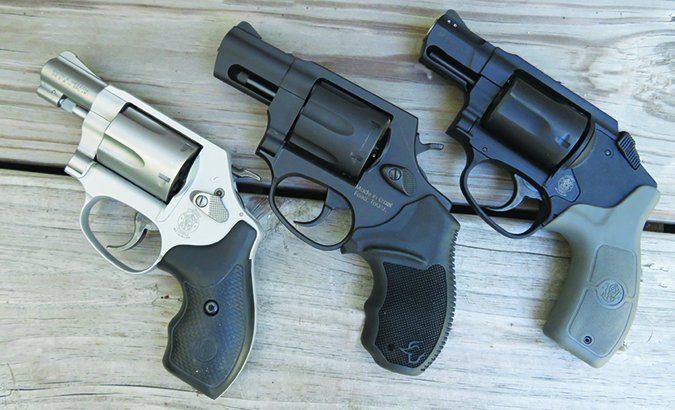
How We Tested
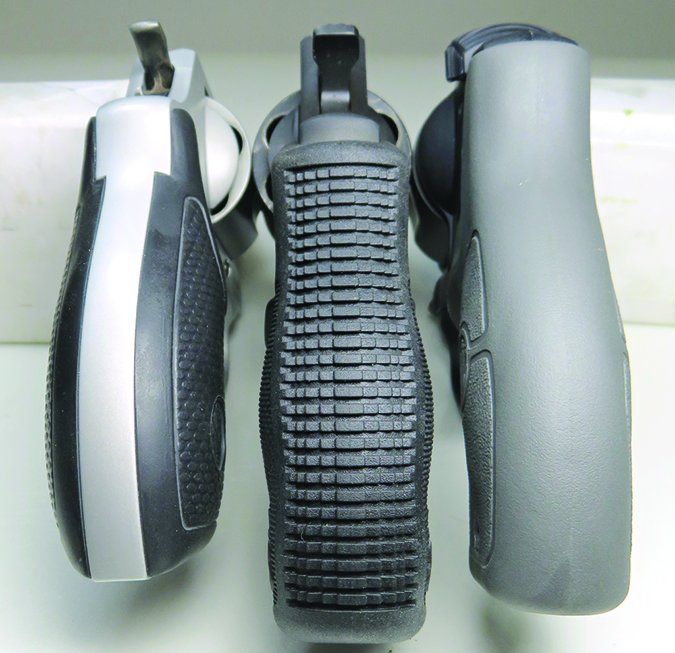
Since these snubnose revolvers are made for concealed carry at short range, we tested at 15 yards using a rest and fired in single-action (SA) mode with the Model 637-2 and Model 856; the M&P Bodyguard 38 is double action only (DAO). With short sight radii, compact grips, and heavy DA triggers on the Model 637-2 and Model 856, we did not expect tack-driving accuracy, but we were surprised at how well we could group shots using the trigger in SA mode. In our opinion, the DA/SA trigger mode on the 637-2 and 856 has an edge over the DAO M&P Bodyguard 38, especially when aiming at a target farther away. The SA trigger mode allows you to more accurately squeeze off a shot. Practically speaking, these revolvers will most likely be used at very close distance and the trigger fired in DA mode. The Bodyguard 38 had a lighter trigger pull in DA than the 637-2 and 856, which allowed better accuracy. We ran a variety of ammunition through the revolvers with full-metal-jacket, lead-roundnose, and jacketed-hollow-point bullets of different weights. For our speed test, we fired two rounds in DA mode as fast as we could into an 8-inch paper plate at 15 yards and found these 38 Special snubnose revolvers had game. Here’s why.
Range Data
| Armscor 38 Sp. 158-gr. FMJ | Smith & Wesson Model 637 | Taurus Model 856 | Smith & Wesson M&P Bodyguard 38 |
| Average velocity | 800 fps | 817 fps | 762 fps |
| Muzzle energy | 225 ft.-lbs. | 234 ft.-lbs. | 204 ft.-lbs. |
| Smallest group | 1 in. | 1.2 in. | 2 in. |
| Average group | 1.1 in. | 1.6 in. | 2.1 in. |
| Federal Champion 38 Sp. 158-gr. LRN | |||
| Average velocity | 653 fps | 652 fps | 653 fps |
| Muzzle energy | 150 ft.-lbs. | 149 ft.-lbs. | 150 ft.-lbs. |
| Smallest group | 1.5 in. | 1 in. | 2.4 in. |
| Average group | 1.6 in. | 1.6 in. | 2.5 in. |
| Speer Gold Dot 38 Sp. 125-gr. GDHP | |||
| Average velocity | 808 fps | 815 fps | 795 fps |
| Muzzle energy | 181 ft.-lbs. | 185 ft.-lbs. | 175 ft.-lbs. |
| Smallest group | 1.4 in. | 0.6 in. | 2.2 in. |
| Average group | 1.6 in. | 0.8 in. | 2.3 in. |
| SIG Sauer 38 Sp. +P 125-gr. JHP | |||
| Average velocity | 869 fps | NA | 892 fps |
| Muzzle energy | 210 ft.-lbs. | NA | 221 ft.-lbs. |
| Smallest group | 0.7 in. | NA | 2 in. |
| Average group | 0.9 in. | NA | 2.1 in. |
| To collect accuracy data, we fired five-shot groups from a bench using a rest. Distance: 15 yards with open sights. We recorded velocities using a ProChrono digital chronograph set 10 feet from the muzzle. *Taurus Model 856 is not rated for 38 Special +P ammunition. | |||
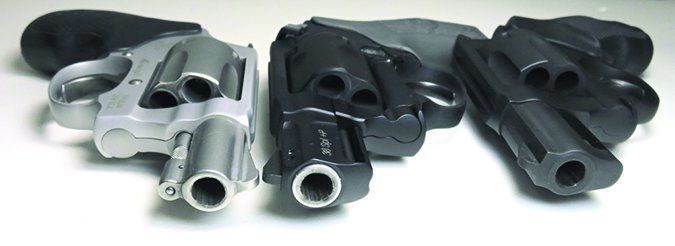
Taurus 856 Model 2-856021 38 Special, $278
GUN TESTS GRADE: A-
The 856 has a consistent trigger pull in double-action or single-action mode, a small grip that feels like a large grip, and it offers 6 shots in about the same package as a 5-shot revolver. The price is reasonable.
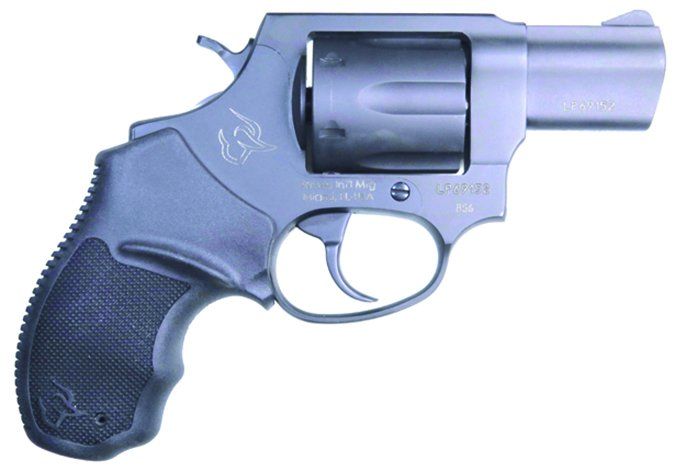
| ACTION TYPE | Double action, single action |
| OVERALL LENGTH | 6.55 in. |
| BARREL LENGTH | 2 in. |
| SIGHT RADIUS | 3.7 in. |
| OVERALL HEIGHT | 4.8 in. |
| MAX WIDTH | 1.4 in. |
| WEIGHT UNLOADED | 22 oz. |
| WEIGHT LOADED | 22.9 oz. |
| CYLINDER GAP | 0.005 in. |
| CAPACITY | 6 |
| FRAME FINISH | Matte black steel |
| BARREL/CYLINDER FINISH | Matte black steel |
| FRAME FRONT STRAP HEIGHT | 2.1 in. |
| FRAME BACK STRAP HEIGHT | 3 in. |
| GRIP | Checkered rubber, finger grooves |
| GRIP THICKNESS | 1 in. |
| GRIP CIRCUMFERENCE | 4.7 in. |
| FRONT SIGHT | Serrated ramp, fixed |
| REAR SIGHT | Groove, fixed |
| TRIGGER PULL WEIGHT (DA) | 12 lbs. |
| TRIGGER PULL WEIGHT (SA) | 5 lbs. |
| TRIGGER SPAN (DA) | 3.1 in. |
| TRIGGER SPAN (SA) | 2.6 in. |
| SAFETY | Internal hammer block |
| WARRANTY | Unlimited lifetime |
| TELEPHONE | (305) 624-1115 |
| WEBSITE | TaurusUSA.com |
| MADE IN | Brazil |
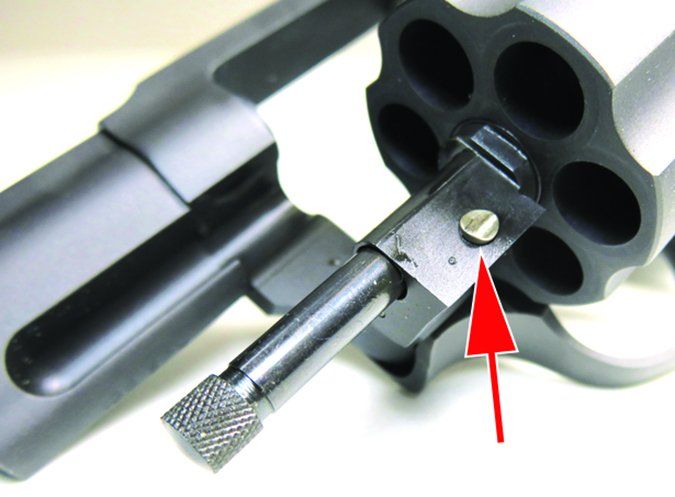
The 856 was introduced this year and offers a 6-shot alternative to Taurus’ Model 85 series of 5-shot concealable revolvers. The added round capacity only increased the width of the revolver by a fraction of an inch and added slightly more weight. We suspect that if Taurus chambered the 856 in 38 Special +P, the revolver would have been beefier and less concealed-carry friendly.
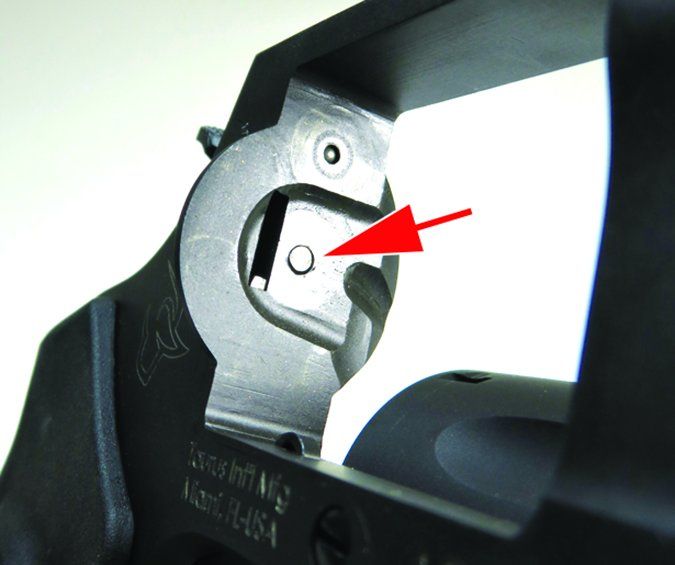
The 856 comes in a cardboard box, and our first impression once it was out of the package was how nicely the revolver settled in our hand. The new textured grip is hand-filling yet adds minimal bulk to the revolver. The plain matte-black finish was well executed, and the crane-to-frame fit was tight. A detent in the top of the crane locks the front of the cylinder into the frame. The cylinder is locked into the rear via a round pin in the extractor. The pin fits into a hole in the rear of the frame. There is no wiggle in the 856. It also had the tighter cylinder gap of all three snub noses. The grip feels comfortable in hand, with most shooters comfortably wrapping their small fingers at the very edge of the butt. This grip made the revolver slightly taller than the other two but it did not interfere with conceal carry.
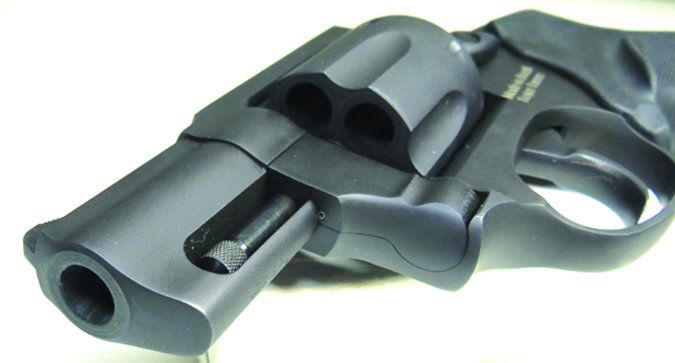
The sights were fixed. The rear sight was a large groove milled out of the top of the top strap and the front sight was milled out of the barrel. The wide front ramp was serrated to reduce glare and the wide rear groove had a cut out to also reduce glare. We liked these sights a lot because the sights were large and the front sight was easily aligned in the rear groove. The barrel incorporates a shroud that protects the ejector rod.
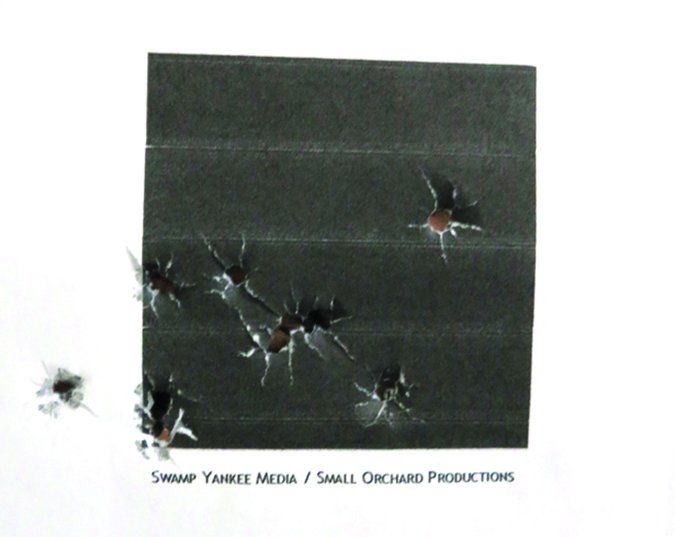
The cylinder latch is pushed forward to swing out the cylinder. It was small and checkered so a speed loader can be used. The design of the grip also allows use of a speed loader. The hammer has a wide thumb pad that is coarsely checkered, allowing us to cock the revolver with confidence. The trigger is smooth and slightly wider than the trigger of the 637-2 and Bodyguard 38.
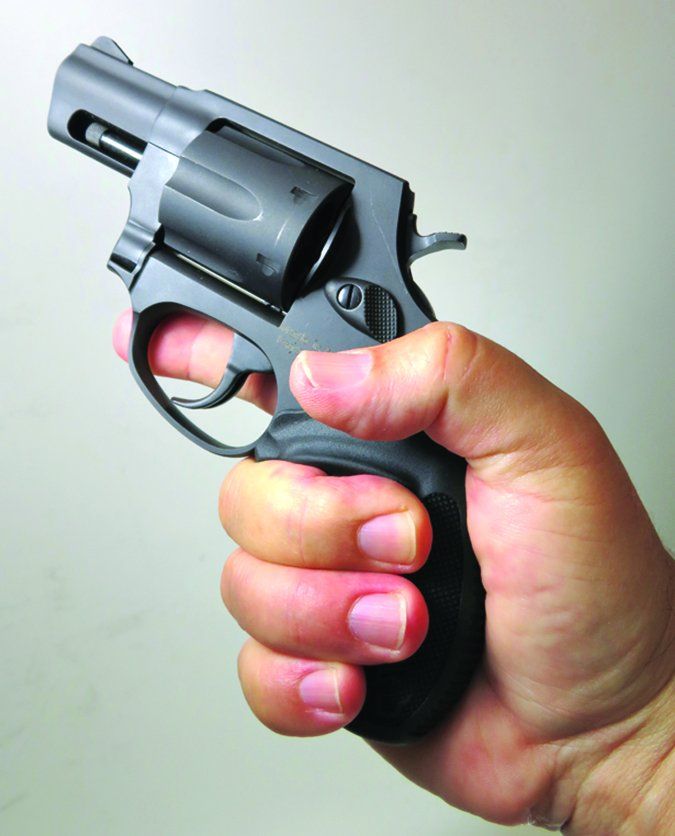
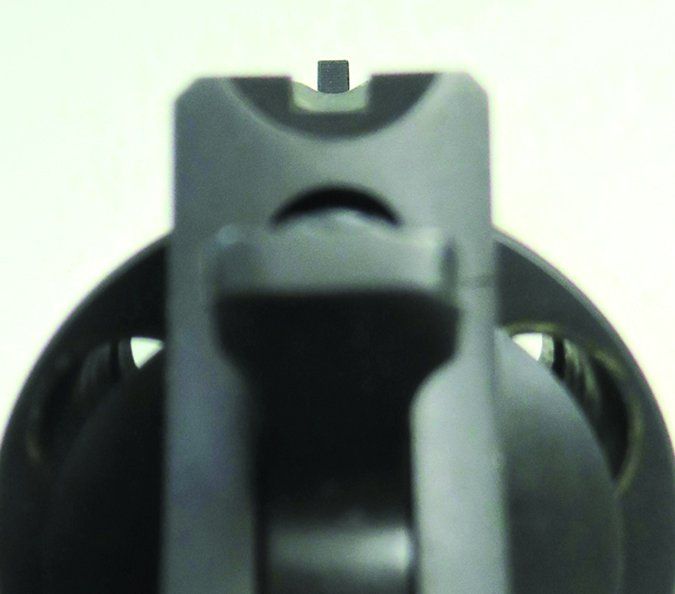
Loading up the 856 we noticed the grip did an excellent job of helping to manage recoil. The extra weight of the steel-frame 856 also helped to manage recoil. It is a pleasant snubnose to shoot. Shooting for accuracy, the 856 tore up the black 2-inch-square target at 15 yards with Armscor 158-grain FMJs. This revolver shot to point of aim. With defensive Speer ammo loaded with 125-grain Gold Dot hollow points (GDHP), one tester fired a 0.6 inch 5-shot group. That’s impressive accuracy out of such a inexpensive revolver. In rapid fire, the groups opened up because the trigger pull was a heavy 12 pounds, though the grip and smoothness made the pull seem less. We used an Uncle Mike’s nylon Sidekick holster to carry the 856.
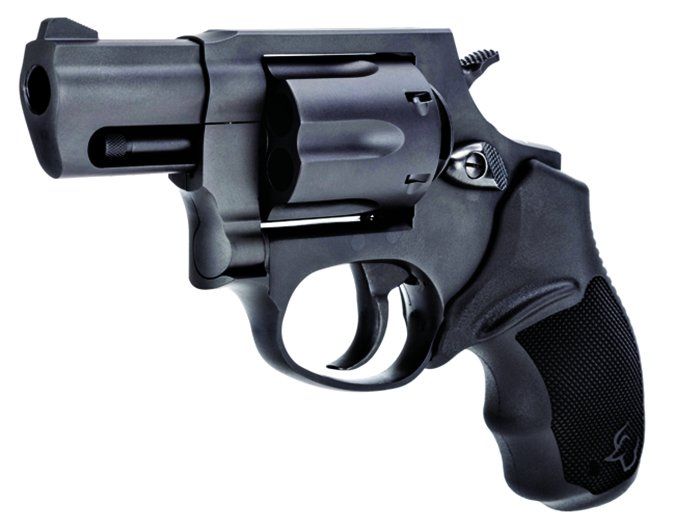
Our Team Said: We really liked this new Taurus. The 6-shot capacity did not make the revolver overly bulky, and the grips were hand-filling yet compact, so felt recoil was less noticeable. The sights were large and easy to use. We would have liked the 856 to be +P ammo compatible, but we recognize there might have been weight and profile trade-offs to gain this capacity. The street price for this revolver is very reasonable.
Smith & Wesson Model M&P Bodyguard 38 103039 38 Special +P, $348
GUN TESTS GRADE: A-
The M&P Bodyguard 38 was easily concealable and lightweight. The DAO trigger pull was smooth. Though it offers only five shots, it is well suited for conceal carry.
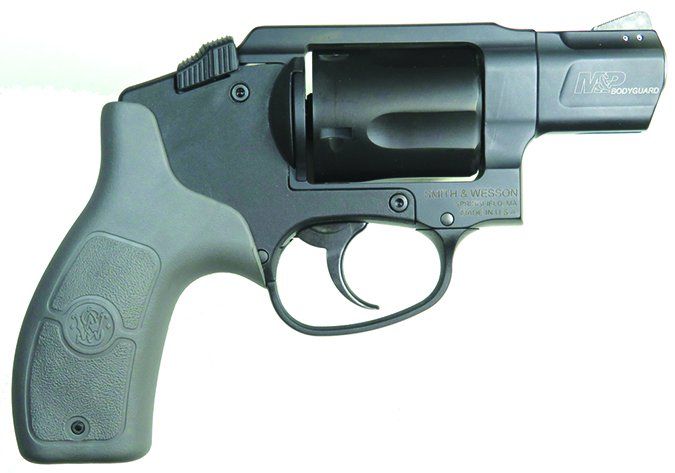
| ACTION TYPE | Double action only |
| OVERALL LENGTH | 6.6 in. |
| BARREL LENGTH | 1.8 in. |
| SIGHT RADIUS | 3.8 in. |
| OVERALL HEIGHT | 4.2 in. |
| MAX WIDTH | 1.3 in. |
| WEIGHT UNLOADED | 14.2 oz. |
| WEIGHT LOADED | 15.1 oz. |
| CYLINDER GAP | 0.011 in. |
| CAPACITY | 5 |
| FRAME FINISH/MATERIAL | Matte black, aluminum alloy |
| BARREL/CYLINDER FINISH | Matte black, stainless steel |
| FRAME FRONT STRAP HEIGHT | 2 in. |
| FRAME BACK STRAP HEIGHT | 3 in. |
| GRIP | Textured polymer, gray |
| GRIP THICKNESS (max) | 0.9 in. |
| GRIP CIRCUMFERENCE (max) | 4 in. |
| FRONT SIGHT | Pinned front ramp |
| REAR SIGHT | Fixed notch |
| TRIGGER PULL WEIGHT (DAO) | 8.3 lbs. |
| TRIGGER SPAN (DAO) | 2.9 in. |
| SAFETY | Internal hammer block |
| WARRANTY | None written |
| TELEPHONE | (800) 331-0852 |
| WEBSITE | Smith-Wesson.com |
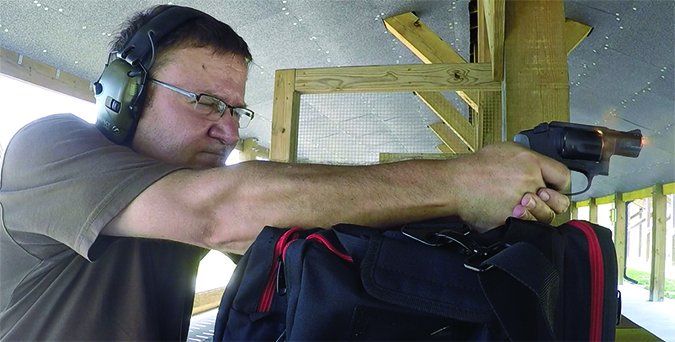
Where the M&P Bodyguard 38 excelled was in its light weight; smooth, light trigger pull; and large, easy-to-acquire sights. It also featured a snag-free exterior that allowed the Bodyguard 38 to be drawn easily from a pant pocket or coat pocket.
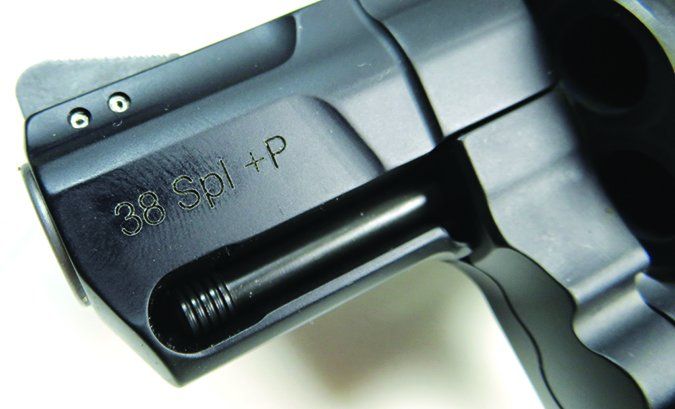
The Bodyguard 38 comes in a soft case. First impression of this snubnose was its weight, or lack thereof. This revolver incorporates a polymer grip and side panels, which dramatically reduce weight. The frame is aluminum alloy, and the stainless-steel barrel has an aluminum shroud that completely covers the ejector rod. S&W did a great job of removing excess metal at the muzzle and around the ejector rod. The ejector rod on the Bodyguard 38 was the longest of the three revolvers, helping the shooter clear empties quickly.
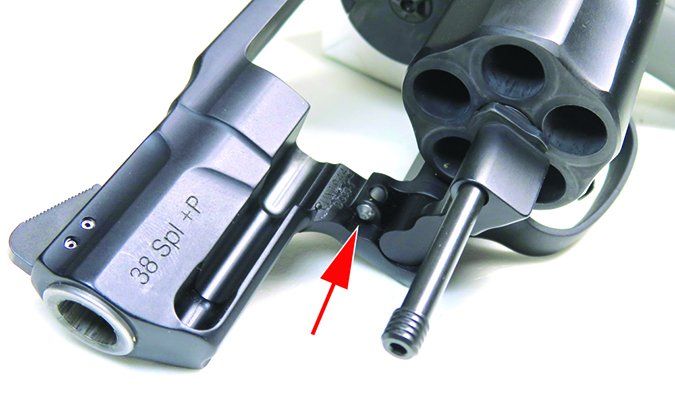
To open the cylinder, the shooter pushes a serrated ambidextrous latch located behind the rear sight groove. A right- or left-handed shooter pushes the latch forward with a thumb to swing the cylinder out. The side of the latch is also serrated, so pushing the latch forward is easier. The Bodyguard 38 has a detent ball built in the front of the frame that locks the crane into the frame. Like with the other revolvers, the shooter needs to push the cylinder out of frame. It won’t swing out on its own. This allows the cylinder to stay in battery in the event the cylinder latch is accidentally manipulated. It was also a new muscle memory task that needed to be learned because most revolvers have a left-side latch.
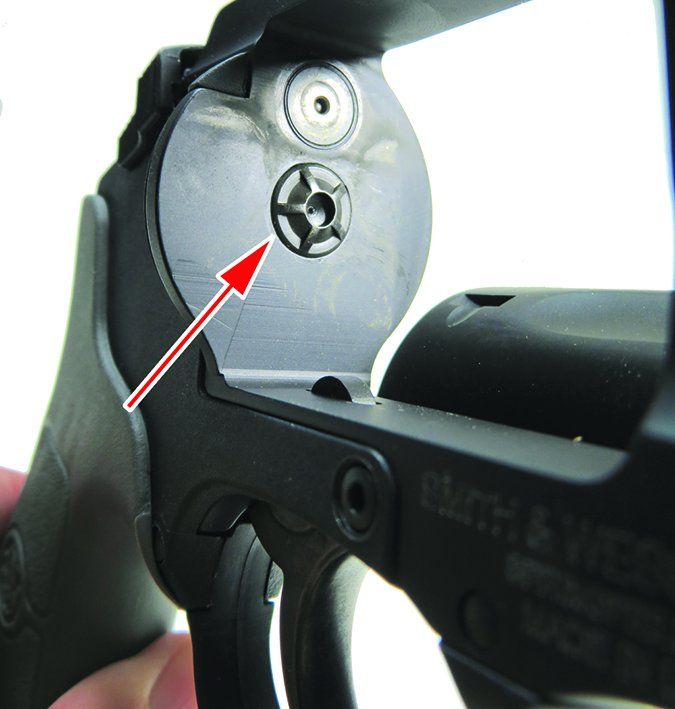
The crane-to-frame fit was tight with no wiggle. The rear of the cylinder is locked in via a star-shaped indent in the extractor that meshes with a star-shaped protrusion in a round section in the rear of the frame, which retracts when the cylinder latch is pushed forward. It should also be noted that the cylinder of the Bodyguard 38 rotates clockwise rather than the traditional counter-clockwise of most other S&W revolvers. Not that this makes a difference in use, but it shows S&W is pushing the design of the revolver with use of polymers and mechanisms.
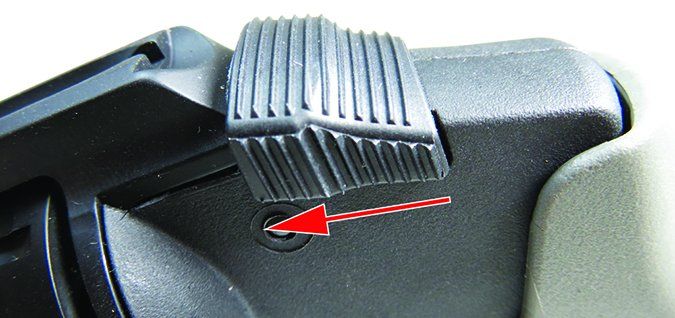
The front-ramp sight is pinned into the barrel shroud so you could replace it to match a specific load or change it to a more visible front sight, such as an XS Sight System standard dot tritium ($71; XSsights.com). The rear sight is a large, squared-off groove milled in the top strap with the rear scooped out to reduce sun glare. We liked these sights in use, and we liked the ability to modify them.
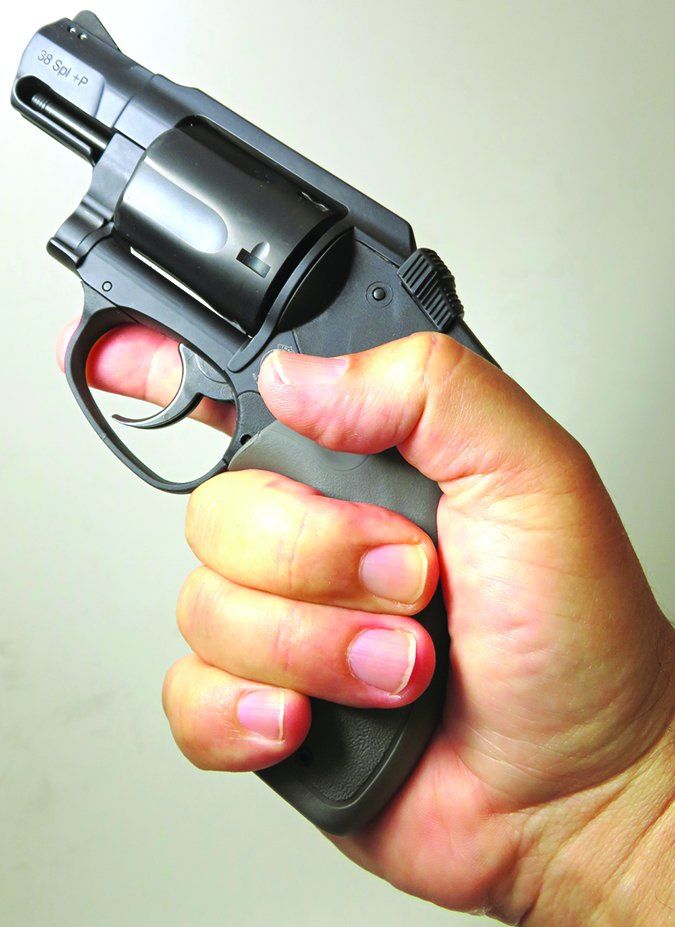
Where we think S&W could improve the Bodyguard 38 is in the grip. The grip allows the user to hold the revolver higher up and closer the axis of the bore, which means recoil is straighter back rather than causing muzzle flip. The grip, however, is small, and when firing +P loads, it transfers recoil. We would want a rubber grip with slightly larger palm swells to make the grip feel larger.
Another feature we liked about the Bodyguard 38 was its snag-free outside exterior. The cylinder had its front edge knocked off, and all the edges were smooth.
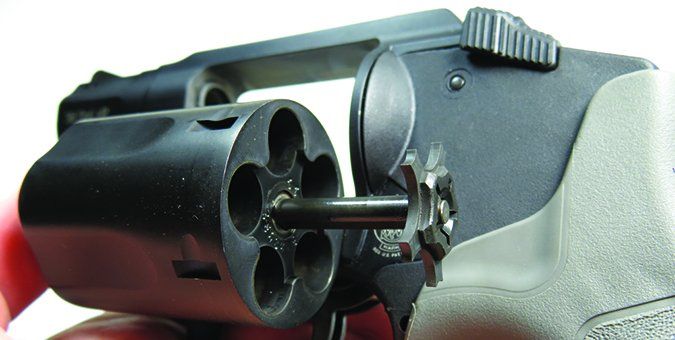
When using the +P ammo, we noticed recoil the most when firing the Bodyguard 38 compared to the other revolvers. The small hard-polymer grip transferred energy into the web of our hands, and some testers had their index-finger knuckles rapped by the rear of the trigger guard. When firing just 38 Special ammunition, the Bodyguard 38 recoil was more tolerable. The trigger pull was DAO and measured 8 pounds, with a slight bit of stacking just before the shot fired. Our 5-shot groups averaged 2 inches at 15 yards, which we thought was excellent for close-range work. We also noted the cylinder gap measured 0.011 inches, which is comparatively large. That dimension allowed some velocity to bleed out with some of the loads.
Our Team Said: We really like the Bodyguard 38 due to its light weight, +P capability, high grip hold, smooth trigger, and sights. The grip could be improved, in our opinion. The price was competitive.
Smith & Wesson Model 637-2 163050 38 Special +P, $389
GUN TESTS GRADE: A
The 637 had all the right quality and features in a concealable revolver: consistent trigger pull, DA or SA trigger mode, recoil absorbing grip, and lightweight.
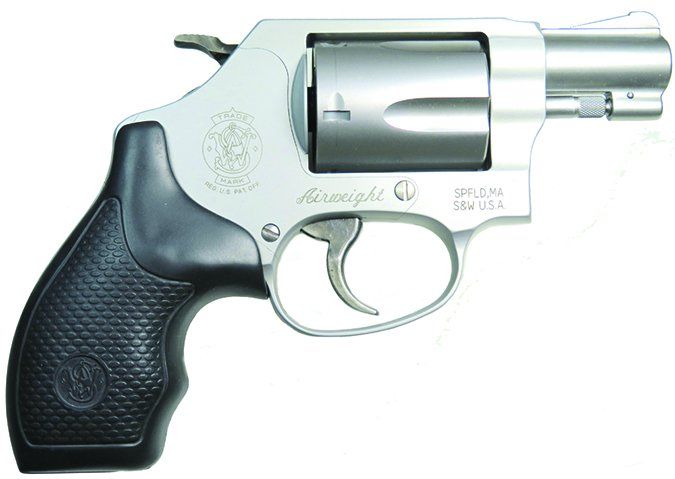
| ACTION TYPE | Double Action/Single Action |
| OVERALL LENGTH | 6.3 in. |
| BARREL LENGTH | 1.8 in. |
| SIGHT RADIUS | 3.5 in. |
| MAX WIDTH | 4.1 in. |
| WEIGHT UNLOADED | 14.4 oz. |
| WEIGHT LOADED | 15.3 oz. |
| CYLINDER GAP | .007 in. |
| CAPACITY | 5 |
| FRAME FINISH/MATERIAL | Matte silver/aluminum alloy |
| BARREL/CYLINDER FINISH | Matte silver/stainless steel |
| FRAME FRONT STRAP HEIGHT | 1.5 in. |
| FRAME BACK STRAP HEIGHT | 3 in. |
| GRIP | Checkered rubber, finger grooves |
| GRIP THICKNESS (max) | 1.1 in. |
| GRIP CIRCUMFERENCE (max) | 4.7 in. |
| FRONT SIGHT | Ramp, fixed |
| REAR SIGHT | Groove, fixed |
| TRIGGER PULL WEIGHT (DA) | 12 lbs. |
| TRIGGER PULL WEIGHT (SA) | 3.8 lbs. |
| TRIGGER SPAN (DA) | 3 in. |
| TRIGGER SPAN (SA) | 2.5 in. |
| SAFETY | Internal hammer block |
| WARRANTY | None written |
| TELEPHONE | (800) 331-0852 |
| WEBSITE | Smith-Wesson.com |
| MADE IN | USA |
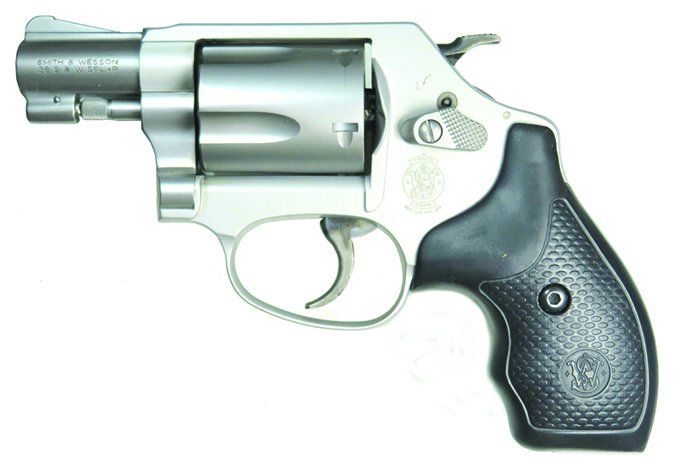
The 637-2 is more of an old-school-style Smith from the 1950s. It reduces weight by using a lightweight aluminum frame and stainless-steel barrel and cylinder. “Airweight” is roll marked on the right side. It is an ounce heavier than the Bodyguard 38.
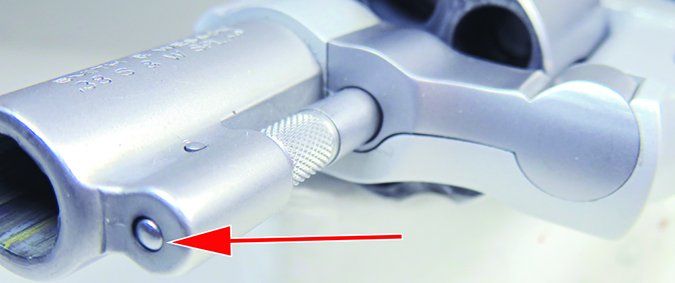
The 637-2 is actually a variation of the Model 37 Chiefs Special Airweight, and it integrates those time-tested features of the original with modern features. The 637-2 comes in a hard-plastic foam-lined case. The finish is a matte silver, with the aluminum frame appearing slightly lighter in tone than the barrel and cylinder. The hammer and trigger are matte black. It is a sharp-looking revolver.
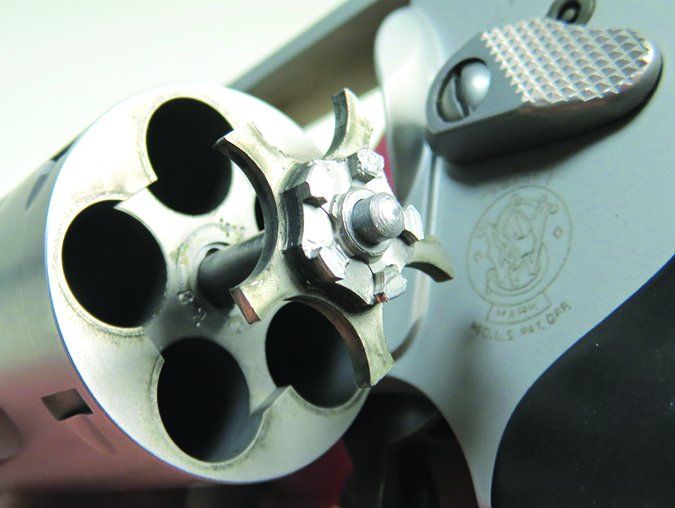
The cylinder latch is traditional and located on the left side of the revolver. It is small and coarsely textured for a sure grip when pressing it forward to swing out the cylinder. It will not interfere when using a speed loader. The 5-shot cylinder locks in the back via a pin in the extractor that fits into a hole in the back of the frame. The front lock up is via the ejector-rod tip and detent in the under-barrel lug. No wiggle at all. Crane and frame mating was tight. The cylinder rotated counter clockwise. What we liked about the 637-2 and the 856 was the ability to see the rear of the cylinder when it was locked in place in the frame. This let us know if the chambers had a cartridge — or empty case — in the chambers. With the Bodyguard 38, the shooter can’t see from the rear if the chambers are filled.
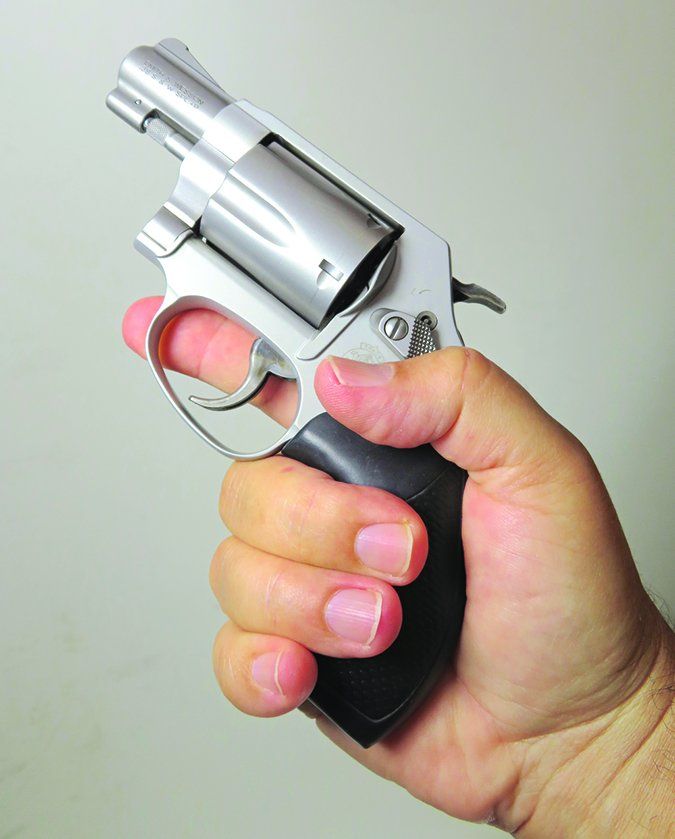
The sights are fixed, and the ramp front sight is machined from the barrel. The ramp is serrated to cut glare. The rear sight is a milled groove in the top strap. It was not as deep as the groove in the other revolvers, and because the finish was matte silver, there was a bit of glare. But the sights were still serviceable.
The hammer spur was small but coarsely checkered, which gave us confidence when cocking the piece to fire it in SA mode. The outside exterior was nearly as snag free as the Bodyguard 38, except for the exposed hammer spur.
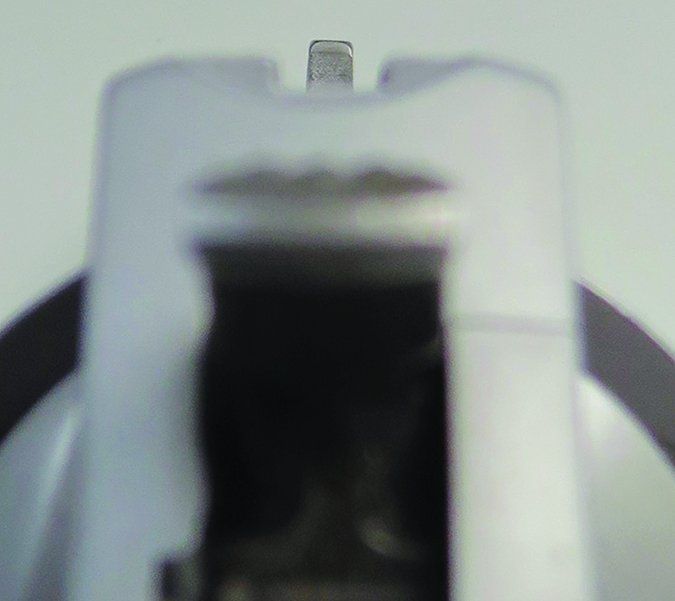
The textured rubber grip is excellent because it has a small footprint, so it is easier to concealed carry, yet it has palm swells that fill your hand. All shooters needed to curl their small fingers under the butt. It was comfortable.
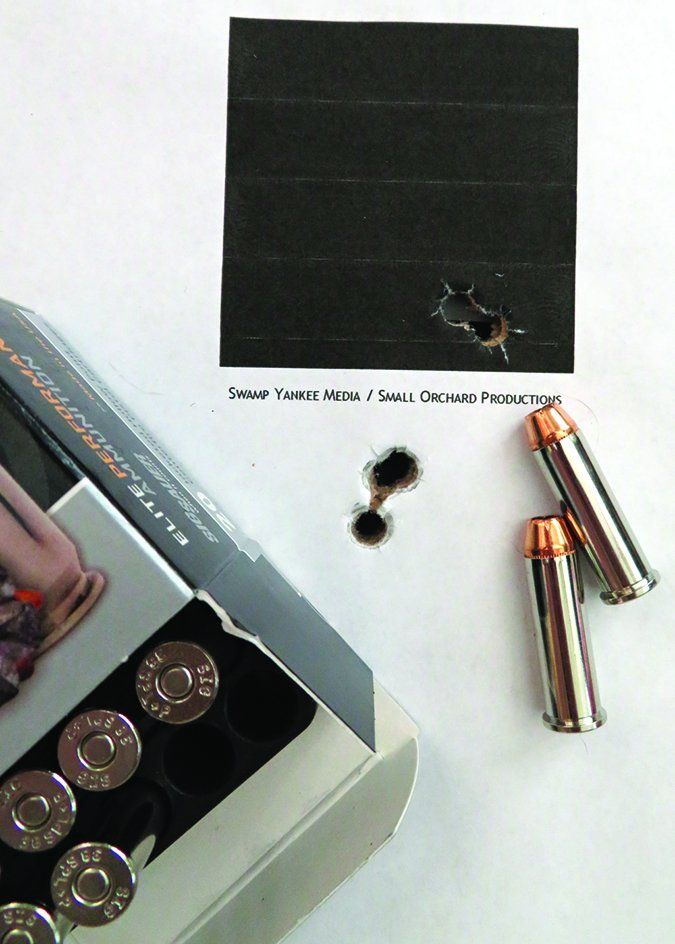
We noted the cylinder gap was 0.007 inches, yet we did not see a great difference in velocity compared to the 856, which had a tight gap that measured 0.004 inches. The DA trigger pull was smooth, and there was a bit of stacking prior to the shot firing, which we felt was fine for the intended purpose of self defense. The SA trigger pull was a crisp 3.8 pounds, and that helped with accuracy testing.
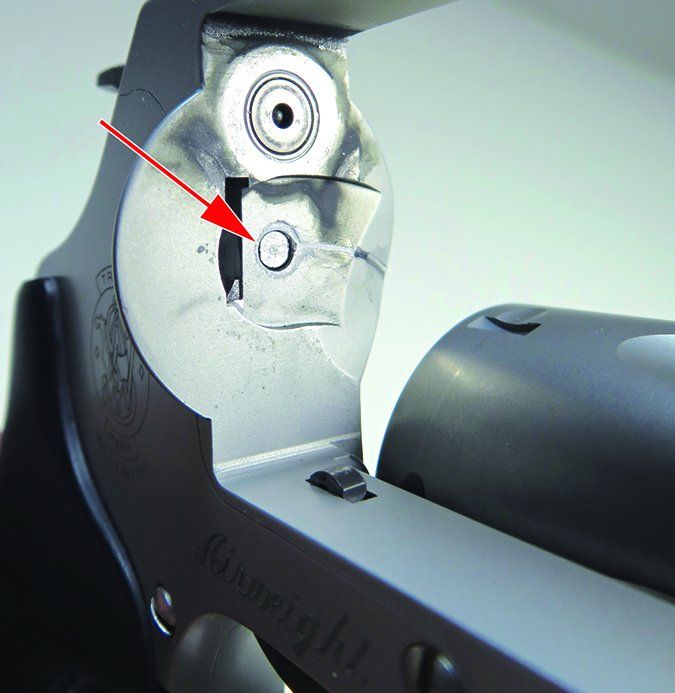
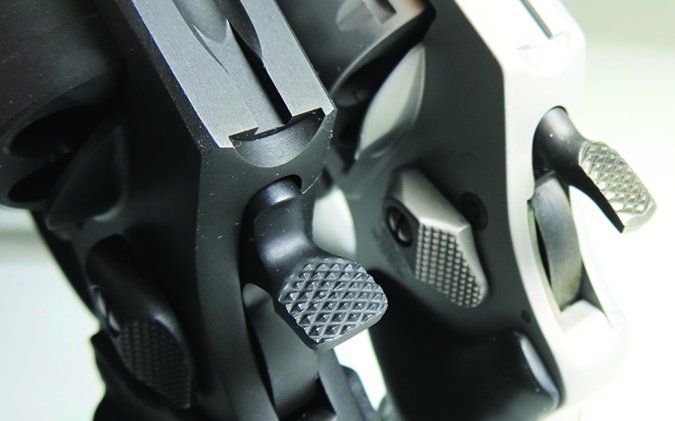
With Armscor 158-grain FMJs, one tester fired a 5-shot group that measured 1.0 inches, and with SIG Sauer +P ammo loaded with 125-grain JHPs, fired a best group of 0.7 inches. This revolver really performed well with all loads hovering around 1.5 inches on average. What we liked was the way the grip helped manage recoil. Though it was small, it felt hand-filling, so it moved less than the Bodyguard 38 in hand during recoil. This grip is smaller than the 856’s grip, so it made the revolver slightly easier to conceal carry. We used a DeSantis leather Cozy Partner to carry the 637-2 and Bodyguard 38. It was very comfortable carrying either Smith.
Our Team Said: There is a reason the 637 is still being built — why fix what isn’t broken? We feel the 637-2 offers the right combination of weight, power, and comfortable shooting. It is a proven design that also incorporates a great grip, good sights, and a smooth DA trigger pull. It cost more, but it is worth it, in our opinion.
Written and photographed by Robert Sadowski, using evaluations from Gun Tests team testers.


























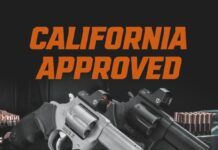


I need the prices of thr three .357 magnums shown
They are all .38 special revolvers in this article.
Need 357 snug nose
I would agree but not with 2 inch or smaller barrels like these snub noses. I would pick a Taurus .357 Defender. While it has the same frame that you see with the taurus revolver in this article it sports a 3 inch barrel instead of the 2 inch barrel. I didn’t know they had a Defender in .357 until last week when I was at Dunhams and saw it.
The Taurus 856 is now +P able. That’s what I like to call it. I have one the full stainless steel version though. It handles better with less recoil because of the added weight. I will tell you I don’t notice the weight when carried in appendix carry. I use a Barsony fabric holster appendix carry and never had its hammer snag while practicing a draw. I like to practice drawing by lifting and clearing shirt when I draw but have no problem not snagging shirt when I don’t lift my shirt. Back to wat I originally wanted to say before I got off topic. When I carry I use +P ammo and shoot 6 rounds of it everytime I get to the range. If I have a good group with the 6 rounds I continue with just regular loads the rest of the range time that day.while it can shoot + P I choose to limit the amount I shoot through it. My overall opinion is that the Taurus 856 stainless steel model ( not lightweight ) is my favorite snub nose revolver.
What do you recommend for a female?